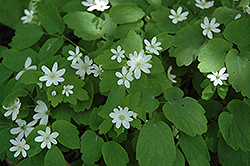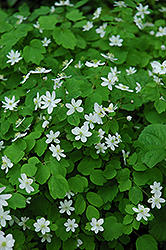Height: 6 inches
Spread: 8 inches
Sunlight:
![]()
![]()
Hardiness Zone: 3a
Other Names: False Rue Anemone
Description:
Dainty white star shaped flowers are nestled on top of rounded, compound leaves; low growing and spreading habit make it ideal for garden beds or borders; easy to grow, requiring little to no maintenance
Ornamental Features
Rue Anemone features delicate white star-shaped flowers with creamy white eyes at the ends of the stems in early spring. Its round compound leaves remain light green in color throughout the season.
Landscape Attributes
Rue Anemone is an herbaceous perennial with a ground-hugging habit of growth. Its relatively fine texture sets it apart from other garden plants with less refined foliage.
This plant will require occasional maintenance and upkeep, and can be pruned at anytime. Deer don't particularly care for this plant and will usually leave it alone in favor of tastier treats. Gardeners should be aware of the following characteristic(s) that may warrant special consideration;
- Spreading
Rue Anemone is recommended for the following landscape applications;
- Rock/Alpine Gardens
- Border Edging
Planting & Growing
Rue Anemone will grow to be only 6 inches tall at maturity, with a spread of 8 inches. Its foliage tends to remain low and dense right to the ground. It grows at a medium rate, and under ideal conditions can be expected to live for approximately 5 years. As an herbaceous perennial, this plant will usually die back to the crown each winter, and will regrow from the base each spring. Be careful not to disturb the crown in late winter when it may not be readily seen!
This plant does best in partial shade to shade. It prefers to grow in average to moist conditions, and shouldn't be allowed to dry out. It is not particular as to soil type, but has a definite preference for acidic soils. It is quite intolerant of urban pollution, therefore inner city or urban streetside plantings are best avoided, and will benefit from being planted in a relatively sheltered location. This species is native to parts of North America. It can be propagated by division.


